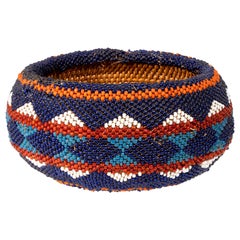Washoe Basket
Vintage 1910s American Native American Native American Objects
Beads
People Also Browsed
Antique 1880s American Native American Native American Objects
Beads
Early 20th Century American Native American Objects
Metal
Late 20th Century American Native American Decorative Baskets
Other
Vintage 1920s American Native American Decorative Baskets
Willow
Antique 1880s American Native American Native American Objects
Beads
Mid-20th Century American Native American Decorative Baskets
Other
Antique 1870s American Native American Native American Objects
Shell
Early 20th Century American Native American Native American Objects
Other
Vintage 1910s American Native American Decorative Baskets
Reed
Antique Late 19th Century American Native American Native American Objects
Hide
A Close Look at Native-american Furniture
Native American broadly describes any Indigenous people in North America and encompasses hundreds of tribes and groups, all with distinct cultures. Native American–style furniture and decor likewise varies widely, from pieces created by Indigenous people to those appropriated by non-native designers.
Indigenous furniture’s rich heritage includes the bentwood boxes of the Northwest Coast carved from cedar for storing household or ceremonial objects. Generations of Native American people have made baskets for holding household items, with those in the Northeast using sweetgrass and those in the Southeast using pine needles and wicker. Artisans in the Plateau region wove watertight pieces like cradles from plant materials. Although these objects were intricately made, they were usually utilitarian rather than decorative.
The colonization of North America and the removal of Indigenous people from their lands led to the suppression of these practices. Many styles that used Native American motifs — such as Southwestern style, which was heavily influenced by the geometric patterns of Navajo textiles — have historically not involved Indigenous creators and, instead, have taken their traditions without their tribal context.
When decorating a home with Native American–style furniture, it is important to do so respectfully, by understanding the origins of motifs and objects and examining who profits from their sale. There are now Indigenous-led companies, such as Cherokee designer Cray Bauxmont-Flynn’s Amatoya and Totem House Design, promoting Indigenous work in furniture and home decor. Supporting Indigenous artists and artisans is essential to confronting the still pervasive issue of cultural appropriation in design.
Find a collection of Native American living room furniture, folk art, rugs and carpets, decorative objects and other items on 1stDibs.
Finding the Right Decorative-baskets for You
Antique and vintage decorative baskets can lend unique charm to any room. And basketmaking is hardly a lost art.
Evidence of basket weaving dates back tens of thousands of years, with one of the most intact examples found in the Judean Desert from the Neolithic period. Historically, baskets have mainly served utilitarian needs — to carry food, store materials and even hold water — but they could also be ornamental objects or have ceremonial or religious purposes.
Native American baskets come from a tradition steeped in generations of skill. There are new and made-to-order baskets from artisans who put their own spin on the ancient art as well as 21st-century pre-owned decorative baskets to complement any furniture style or design preference.
A metal basket or brass basket can match a modern or industrial-style home and add some contrasting rusticity. Wooden baskets, wicker baskets and natural-fiber baskets can easily harmonize with boho chic and cottagecore interiors.
Ceramic baskets are part of the pottery tradition, a craft with a deep heritage in human history. Ceramics are popular in decor again, and the personalization of handmade craftsmanship has served as a sort of anti-Internet to screen-weary decorators. Depending on a ceramic basket’s style, it can fit in with a more formal, cottage, Asian or Southwestern interior theme.
Browse 1stDibs for a wide selection of decorative baskets to fit any design need.
